Article
Nights with Roman Gladiators in Nimes, France
Author(s):
Nimes is the most Roman town in France, yet in some ways is more Spanish than French. In fact, with its long pre-Roman history Nimes was not defeated by Rome but rather accepted as an important trading partner. Just watch out for the $10 Cokes.
Photography by the authors
Nimes is the most Roman town in France, yet in some ways more Spanish than French. Although that’s true of many towns near the Mediterranean Coast in the South of France. They can be culturally more Italian or Spanish depending on how close they are to their neighbor to the east or west.
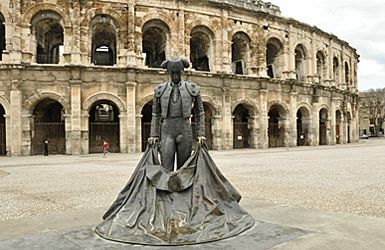
Nimes gives you the flavor of both Spain and Rome at the city’s 2000 year-old coliseum. The massive arena the Romans built around 70 AD held 20,000 spectators. Maybe its size was meant to impress even intimidate the local people because there really weren’t 20,000 persons around at that time.
Our guide, Sophie Bouzat, points out “Nimes with its long pre-Roman history was not defeated by Rome but rather accepted as an important trading partner.†Whatever, the arena is a magnificently preserved Roman monument and in its foreground stands Serena Carone’s striking 1994 statue of the tragic Nimeño II, the matador.
His older brother had been a famous bullfighter and ultimately his manager. Nimeño II and another bullfighter were to fight six bulls in May 1989 but the other matador was injured early and Nimeño II ended up killing all six, an impressive performance that made him the heartthrob of the city.
Four months later a bull tossed him in the air. He landed on his head and was rendered paraplegic. Two years of intense therapy still left him paralyzed on one side. He hanged himself in his garage in November 1991, a heartbreaking figure. Bullfighting may be a barbaric sport but what preceded it here in Roman times was worse, gladiator fighting.
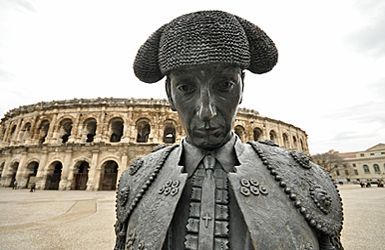
The past is all around Nimes: Francois I awarded the city its coat of arms in 1553. It was based on a Roman coin minted to commemorate the victory of Emperor Augustus over Marc Anthony and Cleopatra at the Battle of Actium, in 31BC when the Romans “chained the Egyptian crocodile to the palm tree.†Small medallions show this logo shining amongst the cobblestones in the streets; a crocodile fountain in Nîmes poses for the visitors; and an easy walk around the corner, in city hall -- four stuffed crocodiles swing suspended as they have for four centuries. Actium was a seminal event for the Roman Empire.

Nimes is not inundated with tourists like Avignon. It is a working city and the people in its streets are local French, not American or German tourists. Says our guide, “It’s compact, clean -- and we’re proud we’ve kept our identity. We’ve maintained our cultural roots, we are a beautiful city and we have some of the most extraordinary gardens in Europe. And Nimes is walkable!â€
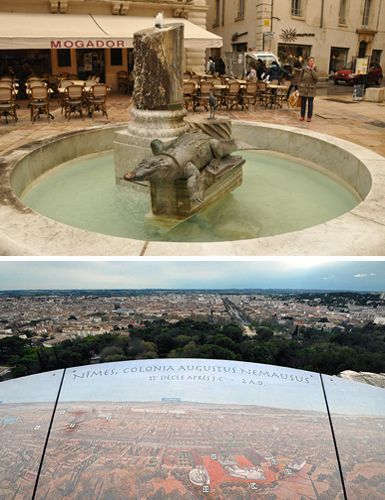
It sure is. It’s about 10 minutes walk from one major attraction to another. However, once you get to the gardens, a vast spread-out complex that was a sanctuary for women in Roman times, there is a lot to cover including the hike not only up to the Roman tower but something like the 144 steps up the circular staircase to the balcony that gives a magnificent panorama of the city.
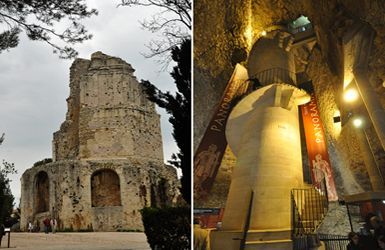
What else can you expect to see as you stroll through Nîmes? If you’re lucky the city will have completed, finally, its several years long renovation of the Maison Carrée, the magnificent Roman temple built on the forum by Agrippa around 12BC. At the moment half of the building is covered with drapes and the interior space is used for a 20-minute presentation about the heroes of Nîmes.
It’s in 3D but surely wasn’t created by James Cameron and your time would be better spent checking out the modern building opposite, the Carrée d’Art. It houses the city library, a museum of contemporary art and a restaurant that has a daily lunch plate for about 12 to 17 Euros. That’s actually value in this country, this continent that mocks the US Dollar.
For example, an insignificant little café on the other side of the Roman temple charges 6 Euros about $10 for two Cokes. Not because it is a foreign drink. Coffee is the same price.
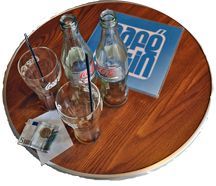
The covered market at Les Halles, a five-minute walk from the forum, justifies a visit. One of the stalls sells Chantilly cream (made from a 17th century recipe) “with lines out into the street at weekends,†says our guide. “Some of the stalls are very specific. For example, that charcuterie over there prepares cured meat but specializes in pata negra, Spanish black pig leg for split pea soup. It is expensive but unbelievably tasty.â€
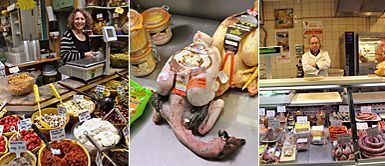
She points to another counter. “Here Stephane Vergne sells 200 different cheeses, all aged by himself.†She gives a self-deprecating smile. “When we go shopping we might buy one cheese at this counter and one more at another. We shop according to our social networks and family traditions – it takes us ages to get our provisions.â€
It doesn’t takes ages for us to suggest we treat our guide to a coffee. We’ve been three weeks in France and we’re dying for a cup of American coffee. There’s a McDonalds just around the corner. Ms Bouzat our guide has the grace not to laugh when we suggest we go there for coffee.
Our other economies in this delightful city where denim cloth originated (de nimes is how denim got its name) included choosing an inexpensive hotel. Acanthe du Temple, booked on the internet, charged us 60 Euros a night – good for Provence but still more than we’d have paid in the United States for a similar quality…but it was within walking distance of the railway station.
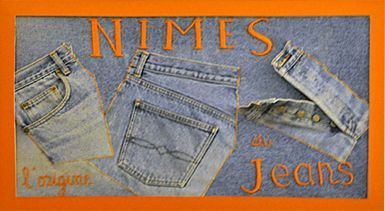
The Andersons, who live in San Diego, are the resident travel & cruise columnists for Physician's Money Digest. Nancy is a former nursing educator, Eric a retired MD. The one-time president of the NH Academy of Family Practice, Eric is the only physician in the American Society of Travel Writers. He has also written five books, the last called The Man Who Cried Orange: Stories from a Doctor's Life.




